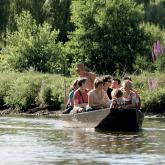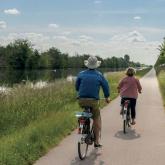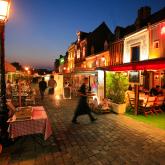Guides and other participants in the Somme Battlefields Partner network
A unique network in France, made up of passionate and inspiring tourism professionals!
These passionate and committed hosts, restaurateurs, tourist offices, visitor sites, guides, taxis, and merchants offer a warm and quality welcome throughout the year. They have a deep knowledge of the battlefields and history of the First World War, and can advise you on aspects not to be missed, discoveries off the beaten track, and will share tips and addresses, and provide you with the full range of tourist documents on the subject. Several British citizens have chosen to come and settle in the Somme area, and manage a guesthouse or work as a guide. It should be noted that all of these Britons, without exception, had a relative in their family who came to fight here.
The Somme Battlefields Partner network certifies Somme battlefield guides and ensures quality of guiding at all levels: standard of knowledge and compliance with current regulations.
Individually or in groups, for a day or half-day, in your vehicle or their minibus, they will guide you around the Somme’s major historical locations.
To experience the battlefields, there is a full range of options:
By horse and cart (Le Hamel) or on horseback (near Villers Bretonneux or Englebelmer), on foot, of course - equipped with a guidebook of the area, by aeroplane (with the Albert Méaulte or Picardie/Amiens Métropole flying clubs), by gyroplane, by bicycle, in a taxi, a chauffeured vehicle or even in a 4X4... You are spoiled for choice, and a stimulating trip always awaits!
Here is the list of guides for the Somme Battlefields network
The East of the Somme and its battlefields are poppy country par excellence. The poppy is the equivalent of the French cornflower, a symbolic means of Remembrance of all wars.
On each of their visits here, they honour their dead with paper poppies on a very simple wooden backing. But where did this practice originate?
In 1915, Lieutenant-Colonel John McCrae, a Canadian medical officer, wrote the famous poem “In Flanders Fields”, on the death of his friend, killed at Ypres, and buried in a makeshift grave marked with a simple wooden cross, wild poppies growing between the rows of graves. The poem would become the symbol of the sacrifice made by the Commonwealth soldiers. In fact, the poppy was the first flower to grow on the ravaged earth of the battlefields, its red colour is reminiscent of spilled blood!
Total losses at this battle are estimated at 1.2 million men, including 420,000 in the British armies and more than 200,000 French. On the German side, 450,000 soldiers were put out of action. The Battle of the Somme was the deadliest confrontation of the Great War. In comparison, the Battle of Verdun left 750,000 men killed, wounded and missing...
To end on a more optimistic note, let us tell you the story of the “Rose de Picardie”. It came about in 1916 on the meeting between a British soldier resting behind the front lines, and local resident (from the village of Warloy- Baillon). Struck by the contrast between the terrible fighting and the peaceful sight of this woman tending her roses, the soldier wrote a poem, a hymn to peace and love. Two years later the text would be taken up by the English composer Haydn Wood, and was then translated into French and underwent various interpretations, including those by Sydney Bechet, Yves Montand, and Tino Rossi…



























